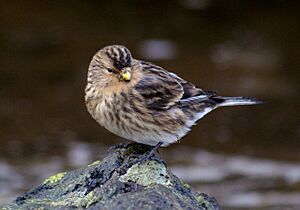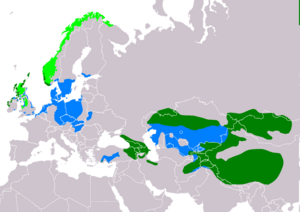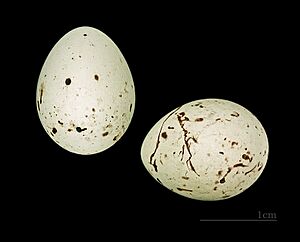Twite facts for kids
Quick facts for kids Twite |
|
|---|---|
 |
|
| Conservation status | |
| Scientific classification | |
| Genus: |
Linaria (bird)
|
| Species: |
flavirostris
|
| Subspecies | |
|
See text |
|
 |
|
| Range of L. flavirostris Breeding Resident Non-breeding | |
| Synonyms | |
|
|
The twite (scientific name: Linaria flavirostris) is a small, brown bird. It belongs to the finch family, called Fringillidae. This bird is known for its unique call, which sounds like "twit"!
Contents
What Does a Twite Look Like?
The twite is about the same size as a linnet, growing to be around 13 to 13.5 centimeters (about 5 inches) long. Unlike linnets or redpolls, it does not have a red patch on its head or chest.
Twites are mostly brown with black streaks on their upper body. They have a pretty pink area on their lower back, called the rump. Their belly is a light tan or whitish color, also with brown streaks.
Their beak changes color with the seasons. It is yellow in winter and turns grey in summer. The twite's call is a clear "twit," which is how it got its name. Its song includes fast, chirping sounds.
Outside of the breeding season, twites often gather in large groups. Sometimes, they mix with other finches. You can find these flocks on coasts and in salty marsh areas. Twites mainly eat seeds.
Where Do Twites Live and How Do They Behave?
Twites breed in northern Europe and across a large area called the Palearctic. This region stretches all the way to Siberia and China. They prefer to build their homes in treeless moorland areas.
Nesting and Eggs
A twite builds its nest in a bush. The female twite usually lays 5 or 6 light blue eggs.
Migration and Movement
Some twites stay in the same place all year. However, many of them migrate to warmer places further south for winter. Others move to coastal areas. Sadly, the number of twites has dropped a lot in some places, especially in Ireland.
Twite Research in the UK
In the United Kingdom, scientists are studying twites in different areas. These include the Pennine hills, the Scottish Highlands, and the coasts of North Wales and Lancashire.
Records show that twites from the eastern Pennine hills fly to the southeast coast for winter. Birds from the western Pennine hills spend winter between Lancashire and the Hebrides islands. The twites from Wales almost always winter in Flintshire.
Scientists use special leg bands to track the birds. This "ringing" data shows that twites breeding in different parts of Britain use different wintering spots. It also shows that British twites do not share wintering areas with twites from mainland Europe.
The Twite's Scientific Name
In 1758, a Swedish scientist named Carl Linnaeus gave the twite its first scientific name, Fringilla flavirostris. This was in his famous book, Systema Naturae.
The name linaria comes from a Latin word meaning "linen-weaver." This is because of the bird's connection to flax plants. The word flavirostris means "yellow-billed," which describes the twite's beak in winter.
For a while, twites were grouped with linnets in a genus called Carduelis. But in 2012, scientists studied their DNA. They found that twites and linnets are different enough to be in their own genus, called Linaria.
Twite Subspecies
There are several different types of twites, called subspecies. Each subspecies has slight differences and lives in a specific area. Here are some of them:
- L. f. bensonorum - Found in the Outer Hebrides (western Scotland).
- L. f. pipilans - Lives in northern Ireland and northern Britain.
- L. f. flavirostris - Found in northern Scandinavia and northwestern Russia.
- L. f. brevirostris - Lives in Turkey, the Caucasus, and northern Iran.
- L. f. montanella - Found from Kyrgyzstan to western China.
- L. f. rufostrigata - Lives in western and southern Tibet, northern India, and northern Nepal.



